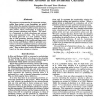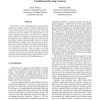334 search results - page 4 / 67 » Standardization in action |
AAAI
1992
14 years 19 hour ago
1992
We propose a representation of concurrent actions; rather than invent a new formalism, we model them within the standard situation calculus by introducing the notions of global ac...
ICCV
2005
IEEE
14 years 4 months ago
2005
IEEE
Most work in action recognition deals with sequences acquired by stationary cameras with fixed viewpoints. Due to the camera motion, the trajectories of the body parts contain no...
CAISE
2001
Springer
14 years 3 months ago
2001
Springer
The UML lacks precise and formal foundations for several constructs such as transition guards or method bodies, for which it resorts to semantic loopholes in the form of “uninter...
ICIP
2009
IEEE
14 years 12 months ago
2009
IEEE
In this paper we propose a new method for human action categorization by using an effective combination of a new 3D gradient descriptor with an optic flow descriptor, to represent...
APSEC
2007
IEEE
14 years 5 months ago
2007
IEEE
Executable UML allows precisely describing the softtem at a higher level of abstraction. It bridges the semantics gap between the UML design models and the implementation. The exe...


